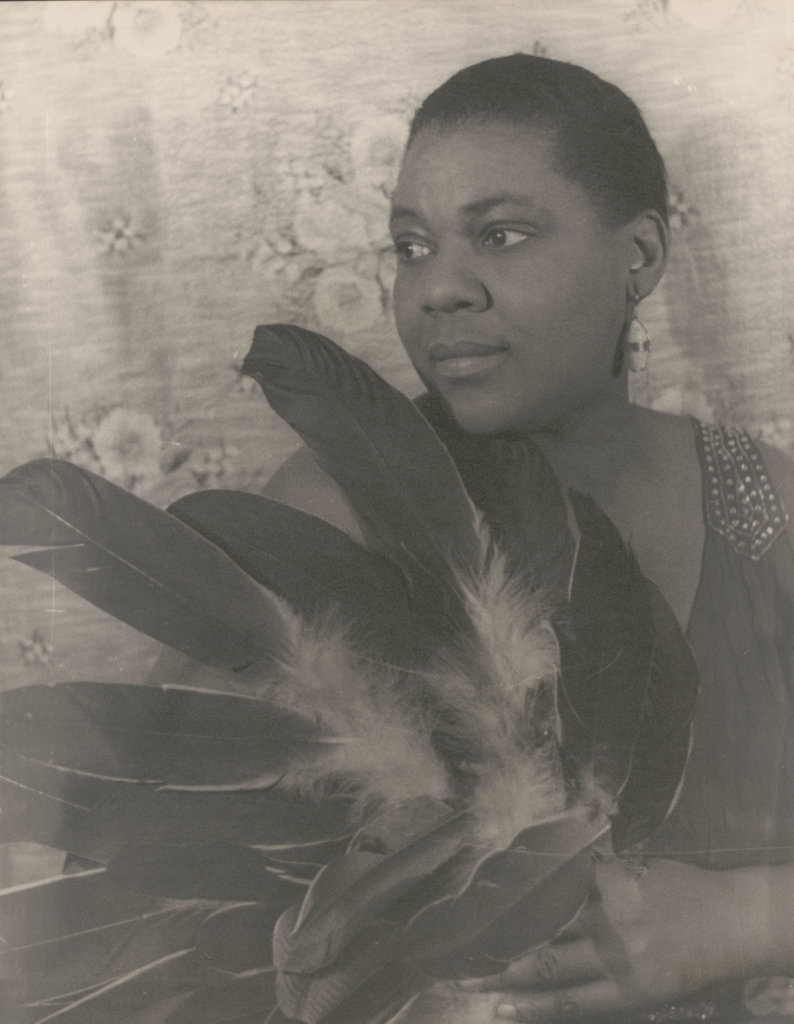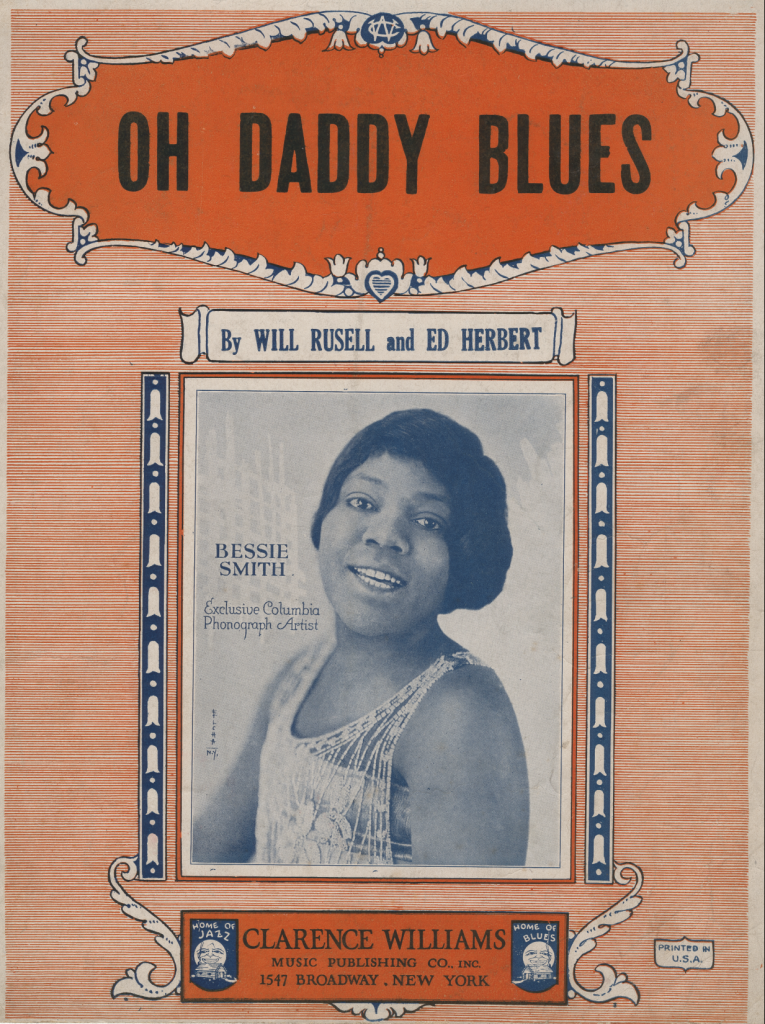Bessie Smith was born in Chattanooga, Tennessee, in 1894 or 1895. Bessie had six siblings. Her family was extremely poor. Her father was a Baptist minister. Both of her parents died when she was young.
Bessie and her brother Andrew made money for the family working as street performers. Bessie sang and Andrew played the guitar. Bessie’s older sister did not think performing was a respectable job, and often punished Bessie for singing in public. But Bessie knew she had talent and refused to quit.
In 1912, Bessie’s brother Clarence invited her to join him as a member of a musical troupe. New opportunities seemed to pop up each time Bessie performed. The famous blues singer Ma Rainey heard Bessie sing and invited Bessie to join her on the road. Ma Rainey taught Bessie how to take care of herself as a young Black woman in the male-dominated entertainment industry. Many historians believe Ma Rainey and Bessie had a sexual or romantic relationship. Although it is generally accepted that Ma Rainey was a lesbian, it is difficult to prove the nature of her relationship with Bessie.
Bessie was eventually offered a chorus girl part in a touring musical. Then she joined a series of vaudeville shows. Vaudeville was a popular form of entertainment at the time and it was deeply segregated. Bessie performed with Black troupes for Black audiences. Each new job kept Bessie traveling up and down the East Coast singing and dancing.
Fans and entertainment professionals agreed Bessie was talented. She sang the blues like no other performer. She could hit low notes clearly and without effort. She brought emotional intensity to her performance. Blues songs are all about feelings—and everyone that heard Bessie felt something deep.
By 1918, Bessie was starring in her own shows. She performed in clubs throughout the South and East. By 1921, she was traveling with her own band. In 1920, Bessie married Earl Love, who died unexpectedly in 1922.
In 1923, an agent at Columbia Records heard Bessie sing and invited her to New York City for an audition. Many recording companies in this era produced “race records,” records by Black artists specifically for Black listeners. The audition went well, and Bessie signed a contract. Columbia promised Bessie $1,500 in exchange for twelve recorded songs. Although white performers at the time had better contracts, Bessie felt it was a good deal. Her first record was “Downhearted Blues.” It sold over 500,000 copies in the first year. As a recording artist at Columbia, Bessie recorded songs with some of the most famous musicians of the era, including trumpeter Louis Armstrong.
Nineteen twenty-three was also the year Bessie moved to Philadelphia and married a man named Jack Gee. Bessie met Jack when he worked as a security guard at a nightclub where she performed. Bessie and Jack’s marriage was messy. Bessie liked to drink and often had affairs with other people. The two divorced in 1929.
Bessie was the highest-paid Black performing artist in the country. She earned almost $2,000 per week traveling as the “Empress of the Blues.”
Bessie’s primary source of income and fame came through endless traveling. Her recordings were so popular that more theaters and clubs wanted to book her. Bessie was the highest-paid Black performing artist in the country. She earned almost $2,000 per week traveling as the “Empress of the Blues.” She was so successful that she bought a custom Pullman sleeping car for the trains that carried her band and their belongings from town to town. Her shows often sold out, and theaters requested additional nights to accommodate more ticket sales. In the summer, she traveled to more remote areas and performed in tents.
Although Bessie was wildly famous, she still maintained some aspects of her life back home. She preferred homemade liquor and home cooking to fancy speakeasies and restaurants. She sent money back to her siblings to help support them. She hired her brother Clarence as her touring manager.
Bessie’s fame began to decline with the start of the Great Depression. The blues was declining in popularity, and record companies were eager to cater to white audiences who preferred jazz. Although Bessie recorded more popular jazz songs, her Southern style was not as attractive anymore. Bessie cut back on her touring show to reflect the times. Her costumes were less elaborate and her songs less bluesy. Sometimes she was booked as the second artist in a show and had to work as a cigarette salesgirl in the audience between acts.
By the mid-1930s, Bessie tried finding more consistent work in New York City. She performed at the Apollo, the Cotton Club, the Harlem Opera House, and other mainstays of the Harlem Renaissance. She also occasionally toured theaters in the South. While she continued to find work, it was nothing compared to her popularity in the 1920s.
On September 26, 1937, Bessie was in a terrible car accident in Coahoma, Mississippi. Her long-time companion Richard Morgan was driving and lost control when he did not see a truck on the road. Bessie suffered severe injuries when she was thrown from the car. She died at the hospital shortly after.
The tragic nature of Bessie’s death made national news. Some historians note she received more attention from white audiences in death than in life.
Although thousands of fans mourned her death, her estate had few funds. Bessie was buried in an unmarked grave in a cemetery in Sharon Hill, Pennsylvania. In 1970, singer Janis Joplin and NAACP leader Juanita Green Smith paid to have her tombstone erected. It reads: “The greatest blues singer in the world will never stop singing.”
Vocabulary
- blues: An African American music form that focuses on melancholy, or sadness. Blues songs tell stories and describe deep emotions. The blues developed in the nineteenth century and gained popularity nationally through the Great Migration.
- Great Depression: The major economic downturn in the started in 1929 and continued through 1939.
- Harlem Renaissance: A term used to describe the intellectual, artistic, and creative output of African Americans in Harlem in the 1920s.
- jazz: A type of music with African American origins the started in the twentieth century. Characterized by strong, regular rhythms.
- Ma Rainey: A famous blues artist who was often described as the “Mother of the Blues.”
- National Association of the Advancement of Colored People (NAACP): A civil rights organization that was founded in 1909 and still exists today.
- Pullman car: A passenger car or sleeping car on a train. The name came from the Pullman Company, which operated many passenger trains in the nineteenth and early twentieth centuries.
- troupe: A traveling group of performers.
- vaudeville: A popular type of entertainment in the early twentieth century that included brief musical numbers and skits.
Discussion Questions
- Describe Bessie’s childhood. How might those early experiences have contributed to her passion for the blues?
- Why was Bessie successful in her career? What talents or skills helped make her so famous?
- Bessie was paid less than many white performers, but still felt her career was a success. Why do you think she felt this way?
- Why did Bessie’s career change after the 1920s? What outside factors contributed to her decline?
- The national media for white audiences paid more attention to Bessie’s tragic death than her talented career in life. What might this tell us about attitudes towards Black Americans and their contributions to wider society?
Suggested Activities
- Use Spotify, YouTube, or another online service to listen to Bessie Smith’s music. Ask students to analyze the lyrics and consider how they relate to Bessie’s life experiences.
- Consider Bessie’s life—and death—within the broader context of race relations in the 1920s. Combine this life story with the Great Migration photographs, the WKKK document, and the life story of Zora Neale Hurston to go deeper.
- Compare Bessie Smith’s life with that of Zora Neale Hurston. Both women were born in the South and traveled extensively. They even met once! How were their lives similar and different, and how do they each exemplify life in the Jazz Age?
- Many of Bessie’s songs dealt with independence, painful romantic and sexual relationships, and the frustrations of male-dominated society. Connect her life story and music to photographs of young women in the 1920s who were experiencing many of these same feelings.
Themes
AMERICAN CULTURE








